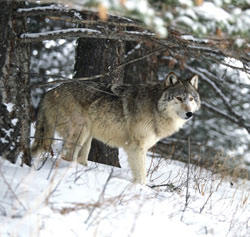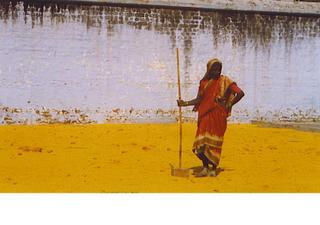The New York Times
September 8, 2005
Alarm Growing on Storm's Cost for Agriculture
By ALEXEI BARRIONUEVO and JEFF BAILEY
CHICAGO, Sept. 7 - Two weeks from the beginning of harvest season, there is a mounting sense of alarm over a potential financial blow to American farming. Farmers in the breadbasket states rely on barges to carry their corn, soybeans and wheat down the Mississippi River, but cannot be certain that the Port of New Orleans, a crucial link to export markets that was badly damaged by Hurricane Katrina, will reopen anytime soon.
In the gulf states, the storm left farmers reeling from numerous other problems, including a lack of electricity to restore chicken and dairy plants to service, and a shortage of diesel fuel needed for trucks to save dying cattle stranded on the breached levees.
For all of them, it is a race against time.
Farmers in some states in the Midwest had already endured the worst drought in almost 20 years. The storm, moreover, flattened sugar cane and rice fields in the South. And farmers nationwide must pay more for fuel to bring the harvest in and transport crops, lowering the profit they will earn when they sell them. Now Hurricane Katrina is adding to the pain by threatening to curtail exports.
In all, the hurricane will cause an estimated $2 billion in damage to farmers nationwide, according to an early analysis by the American Farm Bureau Federation. The estimate includes $1 billion in direct losses, as well as $500 million in higher fuel and energy prices.
Midwestern farmers are threatened by additional losses. Farmers are clearing out stored corn and soybeans to prepare for this year's harvest, which they normally begin exporting at the end of September. But the hurricane caused substantial damage to waterways and grain-handling facilities, and hundreds of barges have been backing up on the Mississippi River with no place to go.
The latest blow to the farm economy comes at a delicate time for the Bush administration, which has been pushing to trim farm subsidies to comply with mounting pressure from the World Trade Organization to level the playing field for producers in developing countries.
The post-Katrina troubles of American farmers could make it tougher for the administration to push through an overhaul of subsidies that is being sought by developing countries. That, in turn, could affect the administration's effort to win new export markets for American production.
Some 27 percent of American farm receipts come from exports.
Higher transportation and logistical costs - including diesel fuel, rail costs and barge rates - are slicing prices producers get for a variety of commodities. Corn prices, for example, have dropped 15 to 20 cents a bushel, or about a 9 percent decrease, based on Wednesday's price of $2.17 a bushel on the Chicago Board of Trade, said Jerry Gidel, an analyst at North America Risk Management Services in Chicago.
The farm sector's problems are in sharp contrast to its good fortune last year. Driven by record-large crops, high beef prices and generous farm subsidies, net farm income hit a record $82.5 billion in 2004. Now the hurricane will put disaster relief programs into play and depress commodity prices, leading to billions of dollars more in government payments to farmers.
Next week, the House and Senate Agriculture Committees are expected to issue reports on how they plan to cut $3 billion in Agriculture Department programs from the federal budget.
Farm groups have been pushing for any trims to take place in the food stamps and conservation programs, while the Bush administration has proposed ending the cotton subsidy program, which the World Trade Organization has ruled illegal in parts after complaints from Brazil and other cotton producers.
But the devastation wrought by the storm - and the ensuing economic impact on farmers both near the gulf and several states away - could alter the debate in Washington and hamper crucial trade talks scheduled for a December meeting of the World Trade Organization in Hong Kong.
"Without question, this makes the reforms that a lot of the rest of the world would like to see happen here in the U.S. a lot more difficult," said Clayton Yeutter, a former secretary of agriculture and United States trade representative. "The general psychology of the event is clearly negative."
In recent weeks, Agriculture Secretary Mike Johanns has been crisscrossing the nation talking to farmers. His message is the need to reduce farm subsidies both to open more export markets to American farmers and to comply with international free trade agreements. "There is a real conditioning going on here," said Keith Bolin, a corn and hog farmer and president of the American Corn Growers Association, who attended a session last week in Decatur, Ill., three days after the hurricane. "Get used to less, get used to less. That's the message."
After two failed efforts at trade negotiations in the so-called Doha round, another failure in Hong Kong could be devastating to developing countries, which are desperate to lift their economies through access to markets in Europe and the United States.
The World Trade Organization is working to remove $280 billion in subsidies among the world's richest countries. Of that, American taxpayers and consumers paid $47 billion to farmers last year, an amount equal to about 20 percent of farm receipts, according to the World Bank.
But Mr. Yeutter and others said the emotional and financial impact of the hurricane on farmers will be tough to ignore in Washington.
The American Farm Bureau Federation estimated that Louisiana would lose two million tons, or 20 percent, of its sugar cane crop. That would reduce the total United States sugar harvest by 3.5 percent, according to the analysis.
In Franklinton, La., a milk-processing plant is struggling without power to dump 60,000 gallons of stored milk that has gone bad. At some nearby Louisiana dairy farms, farmers have continued to milk cows, but with nowhere to sell the milk, they have simply dumped it down the drain.
Some 25 million pounds of milk at plants in Louisiana, Alabama and Mississippi could be lost over the next month if the plants do not return to operation soon, said Michael Danna, a spokesman for the Louisiana Farm Bureau Federation.
Louisiana sugar cane farmers are worried that they may have to delay delivering their crop to mills while they wait for fields to dry long enough to apply an agent that ripens sugar cane, increasing the sugar content and making the crop more salable.
The delay could put the farmers dangerously close to the onset of winter frost, Mr. Danna said.
In Covington, La., thousands of cows are stranded in two feet of brackish water on the levees near New Orleans. Mike Strain, a veterinarian and co-owner of the Strain Cattle Company, struggled Wednesday to find a plane to airlift hay into the area to give his remaining 400 head of cattle "enough strength and energy to get them out of there." Already, well more than half of the 1,100 animals in his herd have perished, costing his company $2 million in uninsured losses.
"The timetable for survival is diminishing rapidly," said Dr. Strain, who is also a state legislator. "The death loss of cattle in southeast Louisiana will be 80,000 to 100,000 head when it's all tallied. That's 50 to 70 percent of the herd here, and that's before disease sets in."
Dr. Strain's rescue efforts are being severely hampered is a lack of diesel fuel to move the cattle to a ranch 100 miles north. "There is no fuel in the service stations that have power. That's just unconscionable."
Government officials are hoping for the best. Mr. Johanns, the agriculture secretary, said Wednesday that he was encouraged by the progress so far in restoring the flow of commerce on the river. He said ships are moving again and the majority of grain elevators in the region are resuming operations, at 63 percent of capacity.
"We are assuring our international customers that we expect minimal disruptions," Mr. Johanns said in a statement. He said workers were focused on restoring power, ensuring adequate staffing and reinstalling navigational aids to allow safe passage of ships.
Given a nighttime curfew, little electric power and potentially hazardous and disease-ridden working conditions, the issue of who will operate the ports remains unclear, with some analysts saying the military or National Guard may have to step in.
A union representative expressed confidence Wednesday that such severe measures would not be needed. The International Longshoreman Association's more than 500 regular New Orleans dock workers - nearly all of them evacuated to other cities - could be ready to work there "immediately,"said Benny Holland, vice president of the union. Additional workers are available, if needed, from regional ports, like Gulfport, Miss., that are not operating, he said.
Most nations that import large amounts of agricultural commodities shipped through New Orleans and other gulf ports have plenty of stockpiles to ride out any disruption in shipping, the Agriculture Department's chief economist, Keith Collins, said in an interview. "I don't think any of them are in any kind of jeopardy," he said.
China, the largest buyer of United States soybeans, for instance, is estimated to have 4.1 million tons on hand, equal to about 10 percent of its annual consumption. Japan, the biggest foreign buyer of American corn, has about 1.3 million tons in storage. "That's a typical number for them,"Mr. Collins said.
Some of the slaughtered chicken in storage at ports in New Orleans and Gulfport was lost, but production, which totals about 8.8 billion broilers a year in the United States, is little affected.





















